new posts in all blogs
Viewing: Blog Posts Tagged with: 2016 early chapter books, Most Recent at Top [Help]
Results 1 - 3 of 3
How to use this Page
You are viewing the most recent posts tagged with the words: 2016 early chapter books in the JacketFlap blog reader. What is a tag? Think of a tag as a keyword or category label. Tags can both help you find posts on JacketFlap.com as well as provide an easy way for you to "remember" and classify posts for later recall. Try adding a tag yourself by clicking "Add a tag" below a post's header. Scroll down through the list of Recent Posts in the left column and click on a post title that sounds interesting. You can view all posts from a specific blog by clicking the Blog name in the right column, or you can click a 'More Posts from this Blog' link in any individual post.
 Alongside yesterday’s easy book list, this is the other list that could have been a little beefier this year. Not a lot of racial diversity to be found, to be frank. That fault lies with me, not the books published in 2016. Still, with that in mind, this list is a collection of great books I read this year but should NOT be taken as the best of the year by any means.
Alongside yesterday’s easy book list, this is the other list that could have been a little beefier this year. Not a lot of racial diversity to be found, to be frank. That fault lies with me, not the books published in 2016. Still, with that in mind, this list is a collection of great books I read this year but should NOT be taken as the best of the year by any means.
2016 Early Chapter Books
Armstrong: The Adventurous Journey of a Mouse to the Moon by Torben Kuhlmann

It’s difficult to know where to put this book, but if I had a gun to my head I’d probably slot it under “early chapter book” rather than “picture book”. Not that it isn’t chock full of gorgeous full color spreads from start to finish. It just has a slightly older feel to it, best suited for those kids willing to sit and listen and contemplate a little more deeply.
Bunjitsu Bunny Jumps to the Moon by John Himmelman
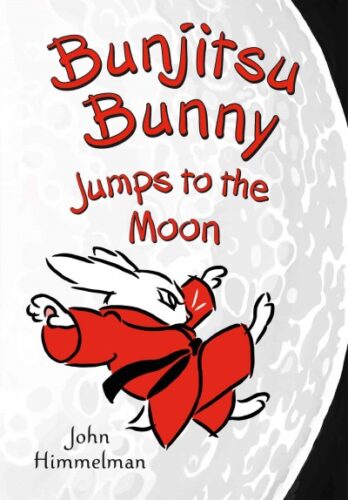
Generally I like to avoid sequels, and this is the third in the Bunjitsu Bunny series. And honestly, I would avoid it, if it weren’t for the fact that it’s just so doggone impressive. With shocking short stories, Himmelman manages to pack a strong punch with a very few number of words. If that man ever gets into easy books, Geisel take note.
Fluffy Strikes Back by Ashley Spires

Clearly I like early chapter books where furry creatures kick things on the covers. This book is a little like a comic and a little like an easy reader. I’m usually wary of spy thrillers done with animals (movies of that sort do not pan out). This, however, is what they all wish that they could be. I may also be inclined towards it since my house is beset by bluebottle flies every summer and no love of mine is lost on them.
The Infamous Ratsos by Kara LaReau, ill. Matt Myers

It doesn’t have the elegance of Bunjitsu Bunny, but LaReau’s tale of two “bad” kids who can’t help but do good felt like it was striking the same notes. Maybe I should have put it on my Books with a Message list.
Juana & Lucas by Juana Medina

I just absolutely, 100% loved this book. I think it was the only early chapter book I went so far as to review this year. The struggle of a girl to learn English (a particularly weird and illogical tongue) will strike a chord with many readers struggling to learn another language.
Narwhal, Unicorn of the Sea by Ben Clanton

Narwhals are hot in 2016. The just keep cropping up! And why not? As this book makes so eminently clear, they are the unicorns of the sea. This upbeat, consistently amusing, warm-hearted little book is perfect for transitional readers that need that comic element to their tales.
The Sandwich Thief by Andre Marois, ill. Patrick Doyon
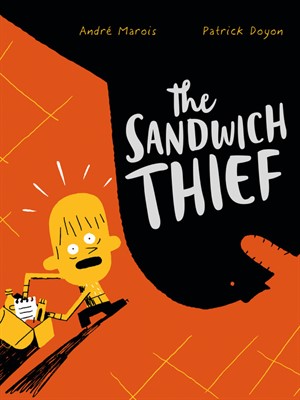
Oops. I lied. I reviewed two early chapter books this year. I have no idea why I adore this one as much as I do. The story of a boy’s incredibly hoity toity sandwich getting stolen every day shouldn’t make me so happy, but it does! It may even make you yearn for homemade mayonnaise. It’s just that convincing.
What’s Up, Chuck? by Leo Landry
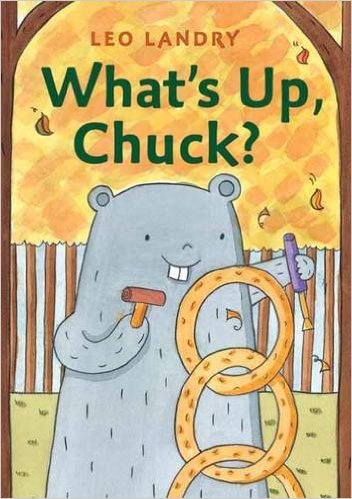
This is one of those books that straddles the line between picture book and early chapter book so perfectly that it should almost be its own category. I decided to put it here, because it actually has a pretty gripping plot. I love what it has to say about personal petty rivalries and dealing with your own jealousy. What kid isn’t going to relate?
Where Are You Going, Baby Lincoln? by Kate DiCamillo, ill. Chris Van Dusen

This is the latest in DiCamillo’s Deckawoo Drive series that began with the Mercy Watson books. It’s unapologetically DiCamilloian. Can you name any other author that could get away with writing an early chapter book about an elderly woman setting off to find herself by riding the rails? It’s engrossing. No animals in it, unlike the other books in the series, so it’s a risk but there are jellybeans so I’m giving it two thumbs up.
Interested in the other lists of the month? Here’s the schedule so that you can keep checking back:
December 1 – Board Books
December 2 – Board Book Adaptations
December 3 – Nursery Rhymes
December 4 – Picture Book Readalouds
December 5 – Rhyming Picture Books
December 6 – Alphabet Books
December 7 – Funny Picture Books
December 8 – Calde-Nots
December 9 – Picture Book Reprints
December 10 – Math Picture Books
December 11 – Bilingual Books
December 12 – International Imports
December 13 – Books with a Message
December 14 – Fabulous Photography
December 15 – Fairy Tales / Folktales
December 16 – Oddest Books of the Year
December 17 – Older Picture Books
December 18 – Easy Books
December 19 – Early Chapter Books
December 20 – Graphic Novels
December 21 – Poetry
December 22 – Fictionalized Nonfiction
December 23 – American History
December 24 – Science & Nature Books
December 25 – Transcendent Holiday Titles
December 26 – Unique Biographies
December 27 – Nonfiction Picture Books
December 28 – Nonfiction Chapter Books
December 29 – Novel Reprints
December 30 – Novels
December 31 – Picture Books


By:
Betsy Bird,
on 10/18/2016
Blog:
A Fuse #8 Production
(
Login to Add to MyJacketFlap)
JacketFlap tags:
international children's books,
Juana Medina,
Best Books of 2016,
2016 reviews,
Reviews 2016,
2016 early chapter books,
Reviews,
Best Books,
Candlewick,
Latino children's books,
early chapter books,
Add a tag
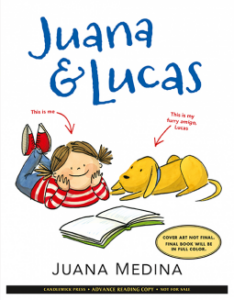 Juana and Lucas
Juana and Lucas
By Juana Medina
Candlewick Press
$14.99
ISBN: 978-1-7636-7208-9
Ages 6-9
On shelves now
Windows. Mirrors. Mirrors. Windows. Windowy mirrors. Mirrory windows. Windows. Mirrors. Sliding doors! Mirrors. Windows.
In the world of 21st century children’s literature, diversity should be the name of the game. We want books for our children that reflect the worlds they know and the worlds they have yet to greet. We want them to see themselves in their books (mirrors), see others unlike themselves (windows), and have a way to get from one place to another (sliding doors). To accomplish this, all you have to do is publish a whole bunch of books about kids of different races, religions, abilities, persuasions, you name it. Great strides have been made over the last few years in the general consciousness of the publishing industry (the publishers, the librarians, the teachers, and even the parents) even as teeny tiny, itty bitty, itsy bitsy tiptoes have been made in terms of what actually is getting published. Much of the credit for spearheading efforts to bring to light more and more books for all children can be given to the We Need Diverse Books movement. That said, our children’s rooms are still filled with monumental gaps. Contemporary Jewish characters are rare. Muslim characters rarer still. And don’t even TALK to me about the state of kids in wheelchairs these days. Interestingly enough, the area where diversity has increased the most is in early chapter books. Whether it’s Anna Hibiscus, Lola Levine, Alvin Ho, or any of the other new and interesting characters out there, there is comfort to be found in those books that transition children from easy readers to full-blown novels. Into this world comes Juana Medina and her semi-autobiographical series Juana & Lucas. Short chapters meet universal headaches (with details only available in Bogota, Colombia) ultimately combining to bring us a gal who will strike you as both remarkably familiar and bracingly original.
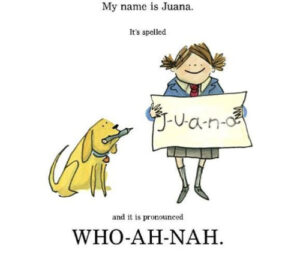 You might think that Juana has it pretty good, and for the most part you’d be right. She lives in Bogota, Colombia “the city that’s closest to my heart” with her Mami. She has a good furry best friend (her dog, Lucas) and a good not-so-furry best friend (Juli). And hey, it’s the first day of school! Cool, right? Only nothing goes the way Juana planned. The whole unfortunate day is capped off when one of her teachers informs the class that they will be learning “the English” this year. Could anything be more unfair? Yet as Juana searches for sympathy amongst her friends and relatives, she realizes that everyone seems to think that learning English is a good thing. Are they crazy? It isn’t until an opportunity comes up to visit somewhere fantastic, far away, and English speaking that she finally takes what everyone has told her to heart. In a big way.
You might think that Juana has it pretty good, and for the most part you’d be right. She lives in Bogota, Colombia “the city that’s closest to my heart” with her Mami. She has a good furry best friend (her dog, Lucas) and a good not-so-furry best friend (Juli). And hey, it’s the first day of school! Cool, right? Only nothing goes the way Juana planned. The whole unfortunate day is capped off when one of her teachers informs the class that they will be learning “the English” this year. Could anything be more unfair? Yet as Juana searches for sympathy amongst her friends and relatives, she realizes that everyone seems to think that learning English is a good thing. Are they crazy? It isn’t until an opportunity comes up to visit somewhere fantastic, far away, and English speaking that she finally takes what everyone has told her to heart. In a big way.
I love, first and foremost, the fact that the emotional crux of this book is fixated on Juana’s detestation of learning “the English”. Now already I’ve heard some commenters online complain that Juana’s problem isn’t something that English-speaking children will identify with. Bull. Any child that has ever learned to read will know where Juana is coming from. What English speaker would fail to sympathize when she asks, “Why are read and read written the same way but sound different? How can I know when people are talking about eyes or ice when they sound about the same? And what about left hand and left the room? So many words, so little sense”? Some kids reading this book may have experience learning another language too. For them, Juana’s complaints will ring true and clear. That’s a key aspect of her personality. She’s sympathetic, even when she’s whining.
For all that we’ve seen books like Juana’s, Lola Levine, Zapato Power, Pedro, First Grade Hero, Sophia Martinez, and a handful of others, interestingly this increase in Latino early chapter book is relatively recent. For a long time it was Zapato Power or nothing. The change is great, but it’s significant to note that all the books I’ve mentioned here are set in the United States. American books set in South American countries where the kids just live their daily lives and don’t have to deal with civil wars or invasions or coyotes or drug runners are difficult to find. What makes Juana and Lucas so unique is that it’s about a child living her life, having the kinds of problems that Ramona or Ruby Lu or Dyamonde Daniel could relate to. And like Anna Hibiscus or The Great Cake Mystery I love books for younger children that go through daily life in other present day countries. Windows indeed.
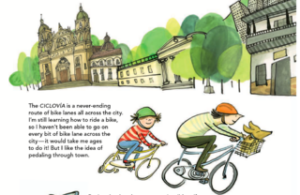 Early chapter books are interesting because publishers see them as far more series-driven than their writers might. An author can crank out title after title after title to feed the needs of their young readers, always assuming the demand is there, and they can do it easier with books under 100 pages than above. Juana could fit the bill in this regard. Her personality is likable, for starters. She’s not rude like Junie B. Jones or willfully headstrong in the same way as Ramona, but she does screw up. She does complain wildly. There are aspects of her personality you can identify with right from the start. I’d be pleased to see more of her in the future, and young readers will undoubtedly feel the same way. Plus, she has one particular feature that puts her heads and tails above a lot of the competition: She’s in color.
Early chapter books are interesting because publishers see them as far more series-driven than their writers might. An author can crank out title after title after title to feed the needs of their young readers, always assuming the demand is there, and they can do it easier with books under 100 pages than above. Juana could fit the bill in this regard. Her personality is likable, for starters. She’s not rude like Junie B. Jones or willfully headstrong in the same way as Ramona, but she does screw up. She does complain wildly. There are aspects of her personality you can identify with right from the start. I’d be pleased to see more of her in the future, and young readers will undoubtedly feel the same way. Plus, she has one particular feature that puts her heads and tails above a lot of the competition: She’s in color.
Created in ink and watercolor, Medina illustrates as well as writes her books. This art actually puts the book in a coveted place few titles can brag. You might ask if there’s a middle point between easy books and, say, Magic Tree House titles. I’d say this book was it. Containing a multitude of full-color pictures and spreads, it offers kids the comfort of picture books with the sensibility and sophistication of chapter book literature. And since she’s already got the art in place, why not work in some snazzy typography as well? Medina will often integrate individual words into the art. They swoop and soar around the characters, increasing and decreasing in size, according to their wont. Periodically a character will be pulled out and surrounded by fun little descriptor tidbits about their personage in a tiny font. Other times sentences move to imitate what their words say, like when Juana discusses how Escanilberto can kick the ball, “hard enough to send it across the field.” That sentence moves from his foot to a point just above his opponent’s head, the ball just out of reach. I like to think this radical wordplay plays into the early reader’s enjoyment of the book. It’s a lot more fun to read a chapter book when you have no idea what the words are going to pull on you next.
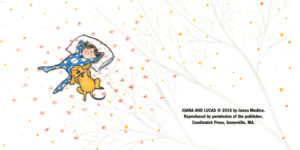 The writing is good, though the conclusion struck me as a bit rushed. Admittedly the solution to Juana’s problems is tied up pretty quickly. She won’t learn, she won’t learn, she won’t learn. She gets to have a prize? She studies and studies and studies. So rather than have her come to an understanding of English’s use on her own, an outside force (in this case, the promise of seeing Astroman) is the true impetus to her change. Sure, at the very end of the book she suddenly hits on the importance of learning other languages and visiting other places around the globe but it’s a bit after the fact. Not a big problem in the book, of course, but it would have been cool to have Juana come to this realization without outside influences.
The writing is good, though the conclusion struck me as a bit rushed. Admittedly the solution to Juana’s problems is tied up pretty quickly. She won’t learn, she won’t learn, she won’t learn. She gets to have a prize? She studies and studies and studies. So rather than have her come to an understanding of English’s use on her own, an outside force (in this case, the promise of seeing Astroman) is the true impetus to her change. Sure, at the very end of the book she suddenly hits on the importance of learning other languages and visiting other places around the globe but it’s a bit after the fact. Not a big problem in the book, of course, but it would have been cool to have Juana come to this realization without outside influences.
As nutty as it sounds, Juana and Lucas is a bit short on the “Lucas” side of that equation. Juana’s the true star of the show here, relegating man’s best friend to the sidelines. Fortunately, I have faith in this series. I have faith that it will return for future sequels and that when those sequels arrive they’ll have a storyline for Lucas to carry on his own. With Juana nearby, of course. After all, she belongs to the pantheon of strong female early chapter characters out there, ready to teach kids about life in contemporary Colombia even as she navigates her own trials and successes. And it’s funny. Did I mention it’s funny? You probably got that from context, but it bears saying. “Juana and Lucas” is the kind of book I’d like to see a lot more of. Let’s hope Ms. Medina is ready to spearhead a small revolution of early chapter book international diversity of her very own.
On shelves now.
Like This? Then Try:


By:
Betsy Bird,
on 2/8/2016
Blog:
A Fuse #8 Production
(
Login to Add to MyJacketFlap)
JacketFlap tags:
Canadian children's books,
Chronicle,
early chapter books,
Patrick Doyon,
2016 imports,
2016 reviews,
Reviews 2016,
2016 early chapter books,
Andrew Marois,
Reviews,
Add a tag
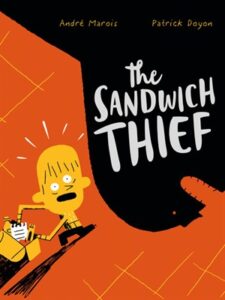 The Sandwich Thief
The Sandwich Thief
By Andre Marois
By Patrick Doyon
Chronicle Books
$14.99
ISBN: 978-1-4521-4659-1
Ages 7-9
On shelves March 1st
Injustice, that sweet universal quality, makes for great children’s books. Whether it’s a picture book or a young adult novel, if you can tap into a reader’s sense of unfairness you have yourself some children’s book gold. It’s the instantaneous gateway to identification. Adults too often forget how painful those early lessons about how the world is an unfair place feel. Children’s books tap into that feeling, while also giving kids a sense of hope. Yes, the world is a mad, bad place sometimes. But there are times when things work out for the best. And if its takes disgusting flavor balls in delicious sandwiches to reach that cathartic ending, so much the better. I wouldn’t argue that Andre Marois’s The Sandwich Thief is the greatest book on this subject I’ve ever seen (it could use a little work in the empathy department), but when it comes to tapping into that feeling of unbridled rage in the face of a cold, calculating world, this title definitely knows its audience.
There are upsides and downsides to having foodies for parents. On the one hand, they can seriously embarrass you when they overdo your school lunches. On the other hand, delicious sandwiches galore! Marin’s a big time fan of his mom’s sandwich constructions, particularly when graced with her homemade mayonnaise, but then one day the unthinkable occurs. Marin goes to take his sandwich to the lunchroom only to find it is gone! When it happens a second time on a second day Marin is convinced that a thief is in his midst. But who could it be? A classmate? A teacher? Everyone is suspect but it’s Marin’s clever mama who knows how to use her mad genius skills to out the culprit, and in a very public way!
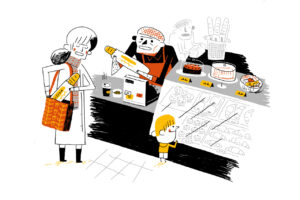 Writing a good early chapter book takes some daring. The form is so incredibly limited. It’s best to have a story that can be read in a single sitting by a parent, or over the course of several attempts by a child just getting used to longer sentences. In this book Marois sets up his mystery with care. There are lots of red herrings, but the author also plays fair, including the true villain amongst the innocuous innocents. The adults made for particularly interesting reading. For example, I loved the portrait of Marin’s principal Mr. Geiger, a man so rumpled and ill-fed you wonder for quite some time how he got his current position (he redeems himself at the end, though).
Writing a good early chapter book takes some daring. The form is so incredibly limited. It’s best to have a story that can be read in a single sitting by a parent, or over the course of several attempts by a child just getting used to longer sentences. In this book Marois sets up his mystery with care. There are lots of red herrings, but the author also plays fair, including the true villain amongst the innocuous innocents. The adults made for particularly interesting reading. For example, I loved the portrait of Marin’s principal Mr. Geiger, a man so rumpled and ill-fed you wonder for quite some time how he got his current position (he redeems himself at the end, though).
I like to tell folks that we are currently in a new Golden Age of children’s literature. This is, admittedly, a fairly ridiculous statement to make since few people can be aware of a Golden Age, even if they are already waist deep in it. Still, the evidence is striking. Never before have authors or illustrators had so much freedom to play around with forms, construction, colors, art styles, etc. It’s not a free-for-all or anything (unless you’re self-publishing) but ideas that publishers might have balked at twenty years ago are almost commonplace today. Take The Sandwich Thief as one such example. Here you have an early chapter book that draws heavily on the classic comic tradition. But speech balloons aside, artist Patrick Doyon makes every single page an eclectic experience. A French-Canadian editorial illustrator who had never made a children’s book prior to this one, in this book Doyon moves effortlessly between two-page spreads, borderless panels, sequential art, the works. You might be so wrapped up in the form that you’d miss how limited his palette is. Working entirely in orange, red, and black, Doyon’s talents are such that you never even notice the missing colors during your reading experience.
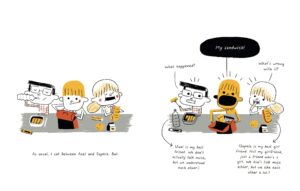 Sadly, there are some aspects to this brand new book that feel like they were written twenty or thirty years ago (and not in a good way). When identifying the potential thieves in his classroom, Marin falls back onto some pretty broad stereotypes. We’re in an era when body acceptance makes old-fashioned fat shaming feel downright archaic. With that in mind, the identification of one student as “Big Bobby” whose “main hobby is eating” is particularly unfortunate. Add in “Poor Marie” whose mom lost her job and can’t afford to eat, and you’ve got yourself an odd avoidance of sympathy. Another reader of this book mentioned that the villains is of a similar lower-socioeconomic level, which is questionable. There are also a couple insults like “Numbnuts” floating about the text that will pass without comment in some households and be a major source of contention in others. FYI.
Sadly, there are some aspects to this brand new book that feel like they were written twenty or thirty years ago (and not in a good way). When identifying the potential thieves in his classroom, Marin falls back onto some pretty broad stereotypes. We’re in an era when body acceptance makes old-fashioned fat shaming feel downright archaic. With that in mind, the identification of one student as “Big Bobby” whose “main hobby is eating” is particularly unfortunate. Add in “Poor Marie” whose mom lost her job and can’t afford to eat, and you’ve got yourself an odd avoidance of sympathy. Another reader of this book mentioned that the villains is of a similar lower-socioeconomic level, which is questionable. There are also a couple insults like “Numbnuts” floating about the text that will pass without comment in some households and be a major source of contention in others. FYI.
Winner of the Governor General’s Literary Award for Illustrated Children’s Literature, French Language, Marois and Doyon’s first collaboration is for any kid that comes in looking for a fun read with a mystery component. With its classy format and striking cover it may even appeal to the Wimpy Kid contingent. Hey, stranger things have happened. It’s a true bummer that the book dumps on so many people along the way but it may still appeal to any kid who craves a little justice in the world. Particularly if that justice comes with the taste of chalk-textured cat pee.
On shelves March 1st.
Source: Final copy sent from publisher for review
Like This? Then Try:
Professional Reviews: Kirkus
Other Jackets:
It can’t really compare to the English language version, but the original French cover is pretty cute too:
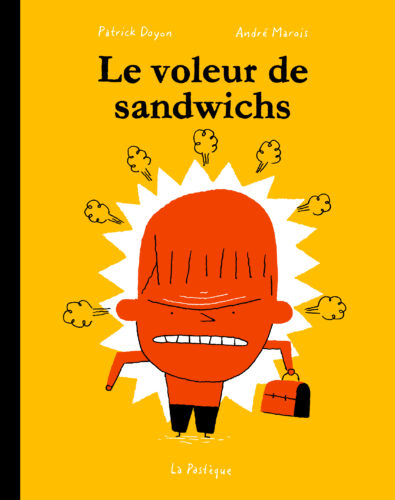

 Alongside yesterday’s easy book list, this is the other list that could have been a little beefier this year. Not a lot of racial diversity to be found, to be frank. That fault lies with me, not the books published in 2016. Still, with that in mind, this list is a collection of great books I read this year but should NOT be taken as the best of the year by any means.
Alongside yesterday’s easy book list, this is the other list that could have been a little beefier this year. Not a lot of racial diversity to be found, to be frank. That fault lies with me, not the books published in 2016. Still, with that in mind, this list is a collection of great books I read this year but should NOT be taken as the best of the year by any means.



















“Numbnuts” – hahahahahahahahahaha!
Oh, that is rich.
Now I really, really, really want to read the book.
The real question is whether or not this is the first instance of “numbnuts” in a book for kids. Clearly it couldn’t be but I’m coming up short finding an equivalent (too blue for Captain Underpants?). What makes it particularly fascinating is that this is a translation. So . . . what was the original word?
Oooh. Good question.
Maybe I’ll track down a copy and give it to our French teacher…
This mystery must be solved!
What’s the French for numbnuts? What’s the French for fiddle-dee-dee?
Easy. Les fiddle-dee-dee.